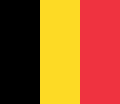Talk:County of Flanders
| This It is of interest to the following WikiProjects: | |||||||||||||||||||||||||||||||||||||||||||||||||||||||
| |||||||||||||||||||||||||||||||||||||||||||||||||||||||
Untitled
[edit]Cities like Tournai and Namur were also part of the County, weren't they? Santori (talk) 21:08, 17 December 2007 (UTC)
Charles the Bald, Holy Roman Emperor
[edit]As far as I remember Charles the Bald has never been Holy Roman Emperor but King of France. His brothers was (Lothar and the Louis the German) were Western Emperor but not Charles proper. I'm editing this now Matthieu (talk) 10:30, 20 March 2008 (UTC)
Cleanup
[edit]This article needs a serious cleanup, most of it don't even relate to the county lifespam. Hóseás (talk) 12:02, 11 February 2014 (UTC)
Rulers?
[edit]The first counties of flanders were margraves actually. The article should stats that. Bertdrunk (talk) 02:32, 7 June 2015 (UTC)
- No one? Bertdrunk (talk) 11:18, 13 June 2015 (UTC)
That's right, will try to change that. AdjectivesAreBad (talk) 22:40, 19 August 2015 (UTC)
External links modified
[edit]Hello fellow Wikipedians,
I have just modified one external link on County of Flanders. Please take a moment to review my edit. If you have any questions, or need the bot to ignore the links, or the page altogether, please visit this simple FaQ for additional information. I made the following changes:
- Added archive https://web.archive.org/web/20100519052941/http://www.nordpasdecalais.fr/reperes/France/Histoire/05/05-04.htm to http://www.nordpasdecalais.fr/reperes/France/Histoire/05/05-04.htm
When you have finished reviewing my changes, you may follow the instructions on the template below to fix any issues with the URLs.
This message was posted before February 2018. After February 2018, "External links modified" talk page sections are no longer generated or monitored by InternetArchiveBot. No special action is required regarding these talk page notices, other than regular verification using the archive tool instructions below. Editors have permission to delete these "External links modified" talk page sections if they want to de-clutter talk pages, but see the RfC before doing mass systematic removals. This message is updated dynamically through the template {{source check}} (last update: 5 June 2024).
- If you have discovered URLs which were erroneously considered dead by the bot, you can report them with this tool.
- If you found an error with any archives or the URLs themselves, you can fix them with this tool.
Cheers.—InternetArchiveBot (Report bug) 19:41, 13 August 2017 (UTC)
Tournai part of Flanders!
[edit]Hello, I notice that on the map (sitatued in 1350) Tournai is an independent area. However, that is not correct. Tournai formed a castellany (administrative area) within the county of Flanders. Tournai only became independent after the annexation of France in the 18th century.
Here, a historical map of Blaeu in 1648 in which Tournai is situated as "Gallo Flandria in qua Castellaniae" roughly translated "a castellany in Walloon Flanders" On all other historical maps between 1100-1700, Tournai is part of Flanders. Could this map be renewed? Tomaatje12 (talk) 12:46, 23 December 2020 (UTC)
Magraviate of Ename?
[edit]The infobox shows a 'Preceded by' of 'Magraviate of Ename'. Besides the spelling mistake which should have this a 'Margraviate', I can find no information on a Margraviate or Margrave of Ename. The link for it goes to an article on the Belgian village of Ename (which I cannot find any information suggesting it had a Margrave). Looking at the information on this page under the History tab, the section on 'Growth in the 9th to the 11th centuries (864-1071)' shows that the county of Flanders originated from the Gau or Pagus Flandrensis. It then follows this up with the first Margrave (Count) of Flanders being Baldwin I.
As Baldwin I was the first Margrave of Flanders from 860-862 before becoming Count of Flanders, and before that there was a Gau/Pagus in the Flanders area (these two terms would have last been used by the Carolingians), I would say that preceding the Margraviate/County of Flanders was The Pagus/Gau Flandrensis which was a Pagus Flandrensis in 745 according to this page as well. I can see no information regarding Ename being a Margraviate, but was a village in the area of Flanders that would have been covered by the Margraviate of Flanders. I can find no information suggesting that the area of Flanders was split into smaller margraviates between the Carolingians and the Margraviate of Flanders.
Is it possible for more information around any 'Margraviate of Ename' to be provided or to consider changing to Pagus Flandrensis or Gau Flandrensis? Pete4131 (talk) 13:46, 18 June 2025 (UTC)
- The Margraviate of Ename existed (Markgraafschap Ename, also known as Rijks-Vlaanderen or as part of Rijks-Vlaanderen together with Aalst), and it didn't really preceed the County of Flanders, it was the part of the county of Flanders which was part of the Holy Roman Empire (hence "Rijks"-Vlaanderen, Rijks = Reich/Empire). See for example this book among many others. So it existed, it was a margraviate, but it's not really a predecessor of the county, more a later expansion. Fram (talk) 14:26, 18 June 2025 (UTC)
- Ename was important when it was built to confront Flanders. After Flanders took it over, it became less important, which is why it is not so well known. Originally Margraviates were typically seems as being on a border (mark/ march). --Andrew Lancaster (talk) 15:42, 18 June 2025 (UTC)
- C-Class level-5 vital articles
- Wikipedia level-5 vital articles in History
- C-Class vital articles in History
- C-Class Belgium-related articles
- High-importance Belgium-related articles
- All WikiProject Belgium pages
- C-Class France articles
- High-importance France articles
- All WikiProject France pages
- C-Class Germany articles
- High-importance Germany articles
- WikiProject Germany articles
- C-Class Netherlands articles
- All WikiProject Netherlands pages
- C-Class former country articles
- WikiProject Former countries articles
- C-Class European history articles
- High-importance European history articles
- All WikiProject European history pages




